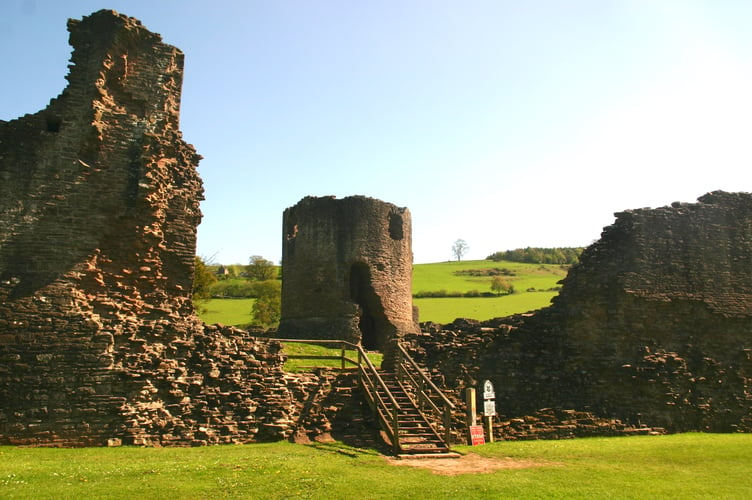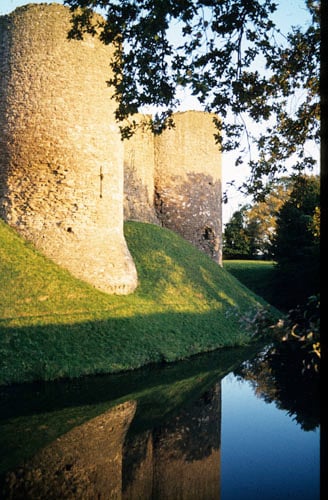Situated in the countryside between Abergavenny and Monmouth, are three Norman fortresses known as Skenfrith, White Castle and Grosmont. Separated from each other by just a few miles, they were built to form a unique triangular unit of defence, and are referred to as the Trilateral Castles.
All my life I have been fascinated by Monmouthshire’s remarkable number of Norman castles, and in 1988, when employed as Chief Countryside Warden for Gwent County Council I set up a project to develop a waymarked walk connecting the Trilateral Castles
A considerable amount of work had to be done by the Warden Service, involving footpath improvements, erection of new stiles and numerous footbridges. This was all undertaken by volunteers working under the direction of the head warden for that area. It took the best part of three years to complete this work and the official opening was held at Skenfrith in 1991.
It was necessary for the walk to be carefully waymarked in order to ensure that walkers keep to the rights of way, and do not trespass over farmland. It is 19 miles in length, and involves several fairly steep ascents, which make it quite challenging to complete it in one day, but very satisfying if you can.
However, to allow more time for appreciating the beauty of this corner of Monmouthshire, and exploring the castles, one can position a car at the end of the first section and do it over two visits.
Skenfrith in the Monnow Valley, is the starting point and this castle is overlooked on all sides by higher ground, which is unusual for such a position would have meant that it was of little strategic value apart from protecting a ford on the river. However, security from attack probably depended largely on the swampy nature of the ground that surrounded the castle.

The name Skenfrith is a corruption of Ynys Cynfraeth, which means Cynfraeth’s Island, and it is thought that he was a 6th century chieftain living here in a fortified dwelling. When the Norman castle was later built, it stood on an island in the marsh, which formed a natural defensive position. Over the years the natural deepening of the river Monnow probably drained the marsh and left the area surrounding the castle as dry land.
The layout of this fortress is very simple for it is enclosed by an irregular shaped curtain wall, buttressed at the four corners by round towers and a circular keep, 40ft high standing on the remains of a small mound. The keep was divided into several floors with access to the first one by a flight of wooden steps.
According to a popular story, Skenfrith Castle and its two neighbouring fortresses were once swopped by King John for three steeds and ten greyhounds. More formal ownership took place In 1936, when the castle was given to the National Trust and it is now looked after by Cadw (Welsh Historic Monuments).
From Skenfrith, the walk takes you across rolling countryside to White Castle (Castell Gwyn), and fragments of plaster adhering to the walls confirm that it was once whitewashed. When seen from a distance it would have been an impressive sight, situated 500ft above sea level.
From the outside, it looks almost intact, and very much as it would have been six centuries ago.The reason why it is the most perfect of the three castles, is because the removal of stones done at Skenfrith and Grosmont would have been more difficult here because of its hilltop situation.
King Stephen in 1184, began constructing White Castle purely as a military fortress, rather than a place of residence, and It is a very good example of a ring castle. The walls are very thick and the outer court which is protected by a water-filled moat 286 yards in circumference, is large enough to contain a small army. A drawbridge spanning the moat would have given access to the gatehouse, but today there is a wooden footbridge that serves this purpose.
In the middle of the 13th century, substantial alterations were undertaken. The keep was demolished and six massive drum towers were erected at intervals around the curtain wall. Accommodation for the garrison was probably in timber buildings erected against the internal walls of the inner ward

At various times, in the 13th century, White Castle was held by the powerful families of De Burgh and De Braose. Edward I later gave the castle and its two neighbouring fortresses to his brother Edmund ‘Crouchback’, the earl of Lancaster, who improved the defences to withstand a possible attack by Llewelyn, the last Prince of Wales. But when he was murdered in 1282 the castle lost its importance as a place of defence and in 1320 it was recorded as being derelict. The Duke of Beaufort bought the property in 1825 and it is now under the protection of Cadw Welsh Historic Monuments
From the top of the gatehouse tower, there is a fine view of the surrounding countryside, for it includes Skirrid Fawr, Blorenge, Sugar Loaf, the Black Mountains and Malvern Hills.
The Three Castles Walk then continues in a northerly direction to reach the sleepy village of Grosmont, which surprisingly was once the third largest town in the county.
The castle, built of pinkish-grey stone stands in a green setting high above the River Monnow and surrounded by a deep dry moat it takes its name from a hill to the south (le Gros Mont) which is known locally as the Graig. This fortress was originally built in the 12th century by Hubert de `Burgh and from about 1267 to the early 14th century, it was held by the Earls and Duked of Lancaster as a favourite residence.
Overlooking the river Monnow, the castle ruins comprise a keep, curtain walls of the inner ward with angle towers, a massive gatehouse and portions of outer defences. It consists of a single horseshoe- shaped ward, and the earliest surviving part is the hall on the north side, which is a solid building set up in about 1210 and measures about 33 yards by 10 yards..
A very striking feature is a 14th century octagonal chimney which springs from one of the walls and known as Eleanor’s Chimney it is named after the wife of Henry II.
From Grosmont the route leads in a southerly direction to complete the three sides of a triangle at Skenfrith, where refreshments can be enjoyed in the Bell Hotel, a 17th century coaching inn.
A detailed guidebook with maps for The Three Castles Walk can be found on the internet by googling: visitmonmouthshire.com




